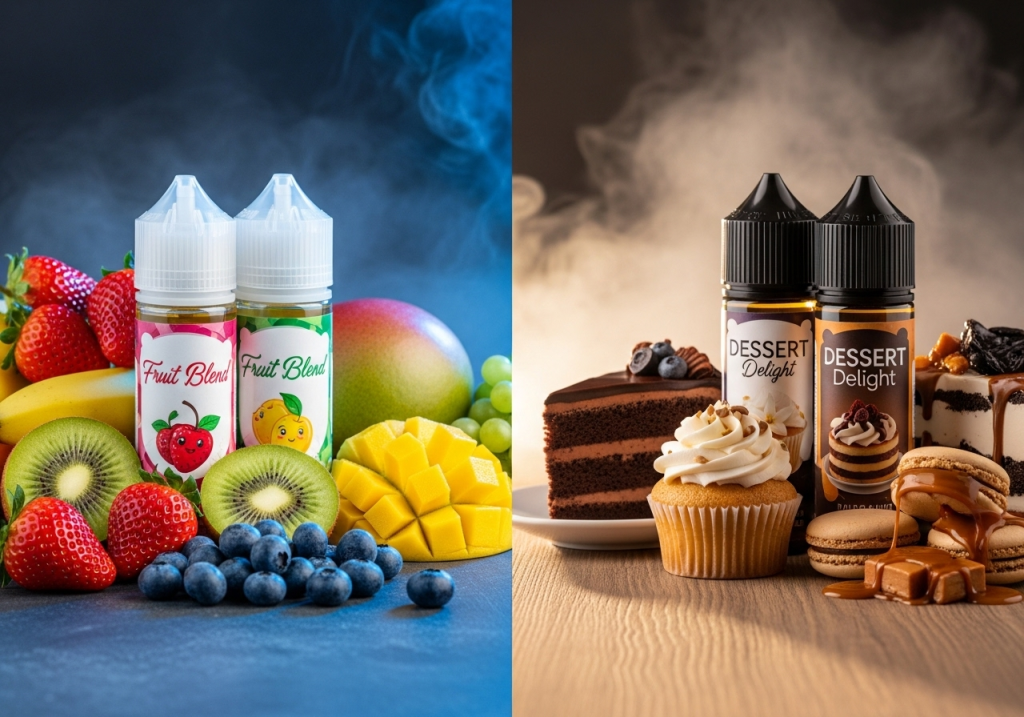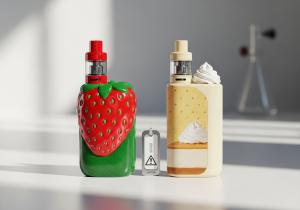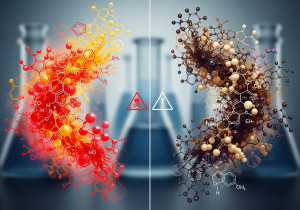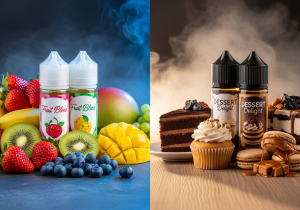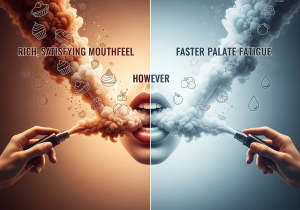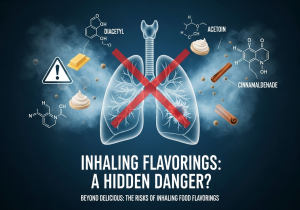You choose fruit flavors because they feel fresher and lighter. You assume they’re a "cleaner" choice than rich dessert vapes, but you’re not entirely sure if they are actually any safer.
No single flavor category is safer than another. Both fruit and dessert vapes use complex, food-grade flavoring compounds. The potential health risk comes from specific chemicals that can be present in either category, not the flavor profile itself, like strawberry versus cheesecake.
From my factory in Shenzhen, I see the science that goes into crafting every flavor. A "simple" fruit taste and a complex dessert one are both built with a blend of specific aroma chemicals. A professional buyer like Matt understands this. He knows that customer perception of "healthy" or "natural" is a powerful force, but it doesn’t always line up with the chemical reality. The truth is, the safety of a flavor has nothing to do with whether it tastes like a mango or a muffin. Let’s break down why.
Key Takeaways:
- Both fruit and dessert vape flavors are made from similar types of food-grade chemical compounds.
- The perceived "lightness" of fruit flavors does not make them chemically safer than dessert flavors.
- User preferences for fruit flavors often relate to all-day vaping, while dessert flavors are seen as an indulgent treat.
- Responsible manufacturing, which avoids known harmful compounds like diacetyl, is the most critical factor for safety, regardless of the flavor profile.
Do Fruit Flavors Contain Fewer Harmful Chemicals Than Dessert Flavors?
You see "Strawberry Ice" and think it’s simple and natural. Then you see "Graham Twist" and assume it’s a complex chemical mix. This leads you to believe one must be safer.
No. Both flavor types are created from a blend of flavoring compounds. A "simple" fruit flavor can be just as chemically complex as a dessert one. The potential for harmful chemicals exists in both, depending entirely on the manufacturer’s formula.
When you vape a "fruit" flavor, you aren’t inhaling vaporized fruit. You’re inhaling a carefully constructed blend of aroma chemicals, the same as you would with a dessert flavor. These are the same types of compounds used to flavor candy, soda, and other food products.
The Building Blocks of Flavor:
Creating any flavor is like painting with chemicals. Different compounds create different notes on the palate.
- Esters: These are a class of organic compounds often used to create fruity scents and tastes. For example, isoamyl acetate is famous for its distinct banana flavor.
- Aldehydes & Ketones: These are often used for bakery, creamy, or nutty notes. Vanillin, for example, is the primary component of vanilla flavor. Cinnamaldehyde provides a cinnamon taste.
Here’s a comparison to show how both profiles rely on specific compounds:
| Flavor Profile | Key Chemical Compounds | Common Perception |
|---|---|---|
| Fruit (e.g., Apple) | Esters like Ethyl Acetate | Simple, natural, light |
| Dessert (e.g., Vanilla) | Aldehydes like Vanillin | Complex, artificial, rich |
A single fruit flavor can contain dozens of these compounds to create a realistic taste. The key takeaway is that both categories draw from the same chemical palette. Responsible manufacturers avoid known harmful inhalants like diacetyl in all their formulas, whether it’s for a fruit or a dessert flavor.
How Do User Preferences Differ Between Fruit and Dessert Vapes?
You find yourself always reaching for the same type of flavor. You might stick to fruits or only crave desserts after dinner, and you wonder why that is.
Vapers often prefer fruit flavors for their light, refreshing taste that is suitable for all-day use. Dessert flavors are typically richer and sweeter, often chosen as an occasional treat, much like a real dessert, because they can be overpowering with constant use.
As a manufacturer, I see global sales data, and the patterns are very clear. The difference in preference isn’t about health; it’s about a concept called "palate fatigue."
Palate Fatigue:
This is when your taste buds become desensitized to a flavor after repeated exposure.
- Fruit and Ice Flavors: These are generally crisp, sharp, and clean. Their profiles are less likely to overwhelm your senses, making them ideal for someone vaping frequently throughout the day. This is why flavors like Blue Razz Ice are consistently best-sellers.
- Dessert Flavors: These are rich, creamy, and complex. While delicious, their intensity can dull your palate quickly. Most users can’t vape a heavy cheesecake flavor all day long without it becoming cloying.
A smart buyer like Matt knows this. He would stock his inventory based on these usage patterns:
| Flavor Type | Typical Use Case | Palate Impact | User Profile |
|---|---|---|---|
| Fruit | All-Day Vaping | Low Fatigue | Seeks a refreshing, consistent experience. |
| Dessert | Occasional Treat, Evening | High Fatigue | Seeks an indulgent, rich flavor session. |
Your choice between a Watermelon Ice and a Graham Twist says more about your personal habits and the experience you’re seeking at that moment than it does about the inherent safety of the product.
Are Dessert-Inspired Vapes More Likely to Encourage Overuse?
You take a puff of a sweet cake flavor, and it’s so good you immediately want another. This makes you worry if these indulgent flavors are pushing you to vape more often.
Possibly, but it’s not a rule. The rich, satisfying mouthfeel of dessert flavors can be highly rewarding, potentially leading to more frequent puffs in a single session. However, their intensity often leads to faster palate fatigue, which can curb long-term overuse.
The connection between sweet tastes and the reward centers in our brains is well-documented. Sweetness can trigger a dopamine release, which makes us feel good and want to repeat the experience.
Rewarding vs. Refreshing:
- The Dessert Reward Loop: A complex, sweet flavor like crème brûlée provides a strong, satisfying sensory experience. This can make you want to "chase" that feeling, leading to chain vaping during a short session. It’s an indulgence.
- The Fruit Refreshment Cycle: A fruit flavor, like Miami Mint, is more about refreshment. You vape it to reset your palate or for a crisp sensation, similar to drinking a glass of cold water. It’s less of an intense "reward" and more of a steady satisfaction.
So, while a dessert vape might encourage you to take five puffs in a row, its richness is also likely to make you put it down for a few hours. In contrast, a lighter fruit flavor might not trigger such an intense immediate craving, but you might find yourself taking single puffs more consistently throughout the entire day. The total daily consumption could end up being very similar. Ultimately, overuse is driven by individual habits and nicotine dependence far more than by the flavor profile itself.
What Do Studies Say About the Health Risks of Flavoring Compounds?
You hear conflicting reports about the dangers of vape flavors. You just want a clear answer on what the science actually says about the risks involved.
Studies show that while most food-grade flavorings are safe to eat, inhaling them is different. Some compounds, like diacetyl (buttery), acetoin (creamy), and cinnamaldehyde (cinnamon), are linked to lung irritation and damage when vaporized and inhaled, regardless of flavor category.
The heart of the safety debate isn’t about fruit versus dessert; it’s about how our bodies process these chemicals when they enter our lungs instead of our stomachs. The digestive system has enzymes and acids designed to break down compounds, but our lungs do not.
Known Chemicals of Concern:
- Diacetyl: This is the most famous example. It’s a chemical that creates a rich, buttery flavor and is perfectly safe to eat. However, when inhaled, it has been linked to a serious lung condition called "popcorn lung."
- Acetoin and Acetyl Propionyl: Often used as substitutes for diacetyl, these also carry potential respiratory risks.
- Cinnamaldehyde: Found in cinnamon flavors, it can be a lung irritant for some people.
A Manufacturer’s Responsibility:
As a manufacturer, this is where our responsibility is greatest. The safety of a vape comes down to the quality of the ingredients and the integrity of the formula.
- Sourcing High-Quality Ingredients: We only use flavorings from reputable suppliers who provide detailed lab reports on their chemical composition.
- Avoiding Problematic Chemicals: We explicitly formulate our e-liquids, both fruit and dessert, to be free of diacetyl, acetoin, and other known chemicals of concern.
The flavor name on the box is marketing. The chemical safety is in the lab report. That’s why choosing a reputable brand that is transparent about its manufacturing standards is far more important than worrying about whether a fruit flavor is "healthier" than a dessert one.
Conclusion
Neither fruit nor dessert flavors are inherently safer. Both use complex chemical compounds. True safety comes from reputable manufacturers who avoid known harmful ingredients across all their flavor profiles, regardless of the taste.
FAQ
Q1: Do "natural flavors" in vapes mean they are safer?
Not necessarily. "Natural flavor" is a regulatory term that means the chemical originated from a natural source (like a plant or animal), but it can be chemically identical to its artificial counterpart. The safety of inhaling it remains the same.
Q2: Why do some fruit vapes taste like candy instead of real fruit?
This is a stylistic choice. Some flavor profiles are designed to mimic the taste of real, fresh fruit, while others are intentionally formulated to taste like popular fruit-flavored candies, which are often sweeter and more intense.
Q3: Are there any vape flavors that are completely risk-free?
No. Inhaling anything other than clean air carries some level of potential risk. However, flavorless vape liquid is generally considered to have fewer unknown variables than flavored options, as it contains only the base liquids (PG/VG) and nicotine.
Q4: How can I know if a vape brand is safe?
Look for brands that are transparent about their manufacturing processes, provide ingredient information, and state that their products are free from known chemicals of concern like diacetyl. Choosing established, reputable companies is always a safer bet.
